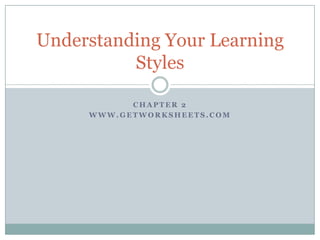
Understanding your learning styles 3
- 1. Understanding Your Learning Styles CHAPTER 2 WWW.GETWORKSHEETS.COM
- 2. Learning Styles Everyone is unique with different ways of doing things, including different learning styles. A specific style of learning indicates how your brain gathers and processes information Understanding what your own style is will help you to choose study methods that are best suited for you. This helps optimal learning and easier recall so that you can excel in the classroom.
- 3. Three Basic Learning Styles Visual Learner Auditory Learner Kinesthetic/Tactile Learner Individuals can have one singular style or possess a combination of two or more styles. Always remember that there is no right or wrong way to learn- Just your way! And knowing your won individual style will give you a big advantage in the classroom
- 4. Visual Learners “Seeing is believing” and visual learners typically learn by what they are able to see or visualize. People who learn better visually usually like to have front row seats, whether in the classroom or at a sporting event or movie theatre for the best view.
- 5. Visual Learners These individuals like to use visual aids such as maps, charts, and diagrams, along with highlighted notes and flashcards to help put material in better perspective. Being able to visualize these images or objects later makes it easier to recall the information when needed. Often visual learners describe things in vivid detail using words to pain a picture.
- 6. Visual Learners Many are good writers and perform well on written assignments. They can process information better when instructions are written down rather than spoken out loud. This sometimes makes following lectures and classroom discussions more difficult, especially if they are unable to take notes.
- 7. Tips For the Visual Learner Use charts, maps, posters, and videos whenever possible to study. Watch the person speaking and observe their body language and facial expressions It’s usually best to study alone in a quiet atmosphere. Use colored highlighters to mark important notes and main ideas.
- 8. Tips For the Visual Learner cont. Write down information that you want to remember such as notes from the board or verbal instructions. Ask for verbal instructions to be repeated for better understanding. Rewrite key points or explanations that are difficult to recall. Whenever possible use your own visual images to relate to the topic being discussed. Look over new material by scanning the pictures and titles/headings before reading.
- 9. Auditory Learners Auditory learners are very good listeners who prefer hearing material rather than reading it. Individuals who have strong auditory processing skills absorb information better through sounds, music, classroom discussions, audio books and verbal instructions. They also prefer giving oral presentations and reports, rather than written ones. Auditory learners are usually more talkative in class and enjoy participating in debates and discussions. While they may struggle with reading, they are often skilled in music and foreign languages.
- 10. Tips for the Auditory Learner Ready study materials, notes, and other information out loud. Study with a friend or in a small group. Listen to audio books whenever possible. Participate in class discussions. Create rhymes to recall dates, names, facts, etc.
- 11. Tips for the Auditory Learner cont. Use word association techniques to memorize facts. Use grid or graph paper to work on math problems. Use colored highlighters to mark important notes and main Ideas.
- 12. Kinesthetic or Tactile Learners Kinesthetic or tactile learners absorb information through the sense of touch, physical activity, and experimental projects. These individuals prefer the hands-on approach to learning new things. While kinesthetic learners may take notes in class or doodle on their papers, they often will not look at their notes again.
- 13. Kinesthetic or Tactile Learners They tend to be feelers and will often stand close to someone when they are talking or touch that persons arm or shoulder. They are usually fidgety or like to have something in their hands, even if it’s just a pencil or paperclip. Individuals who learn best with kinesthetic learning styles are easily distracted. They enjoy, discovering things, classroom participation, arts and crafts, and science projects. Often good at playing musical instruments, martial arts, dance or sports.
- 14. Tips for the Tactile Kinesthetic Learning Get comfortable when studying such as lounging in a chair or comfy couch. Kinesthetic learners are probably the only ones who can study effectively by laying across a bed. Listen to music while studying. Take frequent breaks. Record notes to listen to while walking or exercising.
- 15. Tips for the Tactile Kinesthetic Learning cont… Listen to audio books while walking or exercising. Demonstrate key study points by acting them out or miming to reinforce them in your memory. Hold your book in your hands to read rather than placing it on a table
- 16. Tips for the Tactile Kinesthetic Learning cont… If possible, draw a picture or create a model to clarify the material being studied. Use flashcards and different types of board games to process and reinforce new information. Stand up when called on in class to answer a question. Use colored transparencies to read study materials.